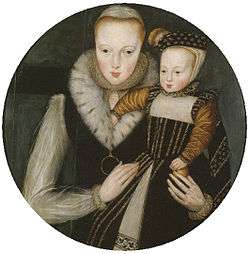Edward Seymour, Lord Beauchamp
| Edward Seymour | |
|---|---|
| Baron Beauchamp of Hatch (courtesy title) | |
|
Edward Seymour and his mother Lady Catherine Grey | |
| Spouse(s) | Honora Rogers |
|
Issue
Edward Seymour, Lord Beauchamp William Seymour, 2nd Duke of Somerset Francis Seymour, 1st Baron Seymour of Trowbridge Honora Seymour Anne Seymour Mary Seymour | |
| Noble family | Seymour |
| Father | Edward Seymour, 1st Earl of Hertford |
| Mother | Lady Catherine Grey |
| Born |
21 September 1561 Tower of London |
| Died | 21 June 1612 (aged 50) |
Edward Seymour, Lord Beauchamp of Hatch (21 September 1561 – 21 July 1612) had a theoretical strong claim to the throne of England, but in reality, he was a cipher whose legitimacy was questioned.
Origins
He was the son of Edward Seymour, 1st Earl of Hertford (1539-1621) by his wife Lady Catherine Grey (d.1568), younger sister of Lady Jane Grey, "The Nine Day Queen". His grandfather was Edward Seymour, 1st Duke of Somerset (executed 1552), all of whose titles became forfeit on his attainder by Parliament, during the reign of his nephew King Edward VI (1547-1553). His father was however re-elevated to the peerage in 1559 by Queen Elizabeth I (1558-1603), as Baron Beauchamp of Hatch and Earl of Hertford. During the lifetime of his father, whom he predeceased, he was known by the courtesy title (his father's lesser title) "Lord Beauchamp".
He was born in the Tower of London, where his mother had been imprisoned for secretly marrying his father, against the wishes of Queen Elizabeth I. His mother was already pregnant when she entered the Tower, and was given poor living conditions, apparently in the hope that she would either miscarry or die. For many years, her children were regarded as illegitimate because no proof could be produced of her legal marriage.
Claimant to throne
By 1603 Edward was the senior qualified heir under the will of King Henry VIII, which stipulated that the elder line of the Stuart dynasty, descended from Margaret Tudor, should be passed-over in favour of the younger line, descended from Mary Tudor, the king's younger and favourite sister. Edward's only possible rival under the will was Anne Stanley, Countess of Castlehaven, who would have been heir had Edward been considered illegitimate. Regardless of Henry VIII's wishes, the succession progressed in favour of the elder line, which resulted in King James VI of Scotland ascending the English throne. Had the stipulations of the King's will been carried out, Edward would have become "King Edward VII" and England and Scotland would not have been placed under a personal union. Queen Elizabeth I never officially dismissed her father's will, but James succeeded through the support of the English Parliament.
Marriage & progeny
Edward married Honora Rogers, daughter of Sir Richard Rogers (c.1527-1605) of Bryanston, Dorset, MP for Dorset in 1572, by his wife Cecilia Luttrell, daughter of Sir Andrew Luttrell (1484–1538), feudal baron of Dunster of Dunster Castle in Somerset.[1] Honora was the sister of Andrew Rogers (d.circa 1599), MP,[2] of Bryanstone, who earlier had married (as his second wife) Lord Beauchamp's aunt Lady Mary Seymour (born 1552). Beauchamp's father the Earl was strongly opposed to the marriage and sent a certain George Ludlow to discuss the position with the Rogers family. Ludlow reported back that Honora was "a baggage" and her father Sir Richard Rogers "a fool" and that Lord Beauchamp had originally intended to have "but a night’s lodging with her". The Earl believed that Sir Richard had encouraged the marriage and that "though outwardly he did nothing" to oppose or promote the marriage, nevertheless his daughter had "inwardly his goodwill".[3] By his wife Honora he had progeny three sons and three daughters:
- Edward Seymour, Lord Beauchamp (1586–1618), who married Lady Anne Sackville, daughter of Robert Sackville, 2nd Earl of Dorset. He predeceased his grandfather the 1st Earl of Hertford and died without issue.
- William Seymour, 2nd Duke of Somerset (1588–1660) and 2nd Earl of Hertford, who in 1660 eventually regained the Dukedom which had been granted to his great-grandfather Edward Seymour, 1st Duke of Somerset (c. 1500–1552).
- Francis Seymour, 1st Baron Seymour of Trowbridge (c. 1590–1664), of Marlborough Castle, the grandfather of Francis Seymour, 5th Duke of Somerset (1658-1678) and of his younger brother Charles Seymour, 6th Duke of Somerset (1662-1748), "The Proud Duke".
- Honora Seymour (bef. 1594–1620), wife of Sir Ferdinando Sutton, son of Edward Sutton, 5th Baron Dudley.
- Anne Seymour
- Mary Seymour
Death & succession
He predeceased his father the 1st Earl of Hertford, and was succeeded in the courtesy title by his eldest son Edward Seymour, Lord Beauchamp (1586–1618), who also predeceased the 1st Earl, and it was thus his second son William Seymour, who in 1621 succeeded his grandfather as 2nd Earl of Hertford and in 1660 was restored as 2nd Duke of Somerset. His monumental brass inscription survives in Great Bedwyn Church (the parish church of Wulfhall and Tottenham Lodge), inscribed in Latin as follows:[4]
- Bellocamp(o) eram, Graia genetrice, Semerus. Tres habui natos, est quibus una soror ("I was Beauchamp, a Seymour, by my mother Grey. I have had three born from which one a sister")
Ancestry
| Ancestors of Edward Seymour, Lord Beauchamp | ||||||||||||||||||||||||||||||||||||||||||||||||||||||||||||||||||||||||||||||||||||||||||||||||||||||||||||||||||||||||||||||||||||||||||||||||||||||||||||||||||||||||||||||||||||||||||||||||||||||||||||||||||||||||||||||||||||||||||||||||||||||||||||||||||||||||||||||||||||||||||||||||||||||||||||||||||||||||||||||||||||||||||||||||||||||||||||||||||||||||||||||||||||||||||||||||||||||||||||||||||||||||||||||||||||||||||||||||||||||||||||||||||||||||||||||||||||||||||||||||||||||||||||||||||||||||||||||||||
|---|---|---|---|---|---|---|---|---|---|---|---|---|---|---|---|---|---|---|---|---|---|---|---|---|---|---|---|---|---|---|---|---|---|---|---|---|---|---|---|---|---|---|---|---|---|---|---|---|---|---|---|---|---|---|---|---|---|---|---|---|---|---|---|---|---|---|---|---|---|---|---|---|---|---|---|---|---|---|---|---|---|---|---|---|---|---|---|---|---|---|---|---|---|---|---|---|---|---|---|---|---|---|---|---|---|---|---|---|---|---|---|---|---|---|---|---|---|---|---|---|---|---|---|---|---|---|---|---|---|---|---|---|---|---|---|---|---|---|---|---|---|---|---|---|---|---|---|---|---|---|---|---|---|---|---|---|---|---|---|---|---|---|---|---|---|---|---|---|---|---|---|---|---|---|---|---|---|---|---|---|---|---|---|---|---|---|---|---|---|---|---|---|---|---|---|---|---|---|---|---|---|---|---|---|---|---|---|---|---|---|---|---|---|---|---|---|---|---|---|---|---|---|---|---|---|---|---|---|---|---|---|---|---|---|---|---|---|---|---|---|---|---|---|---|---|---|---|---|---|---|---|---|---|---|---|---|---|---|---|---|---|---|---|---|---|---|---|---|---|---|---|---|---|---|---|---|---|---|---|---|---|---|---|---|---|---|---|---|---|---|---|---|---|---|---|---|---|---|---|---|---|---|---|---|---|---|---|---|---|---|---|---|---|---|---|---|---|---|---|---|---|---|---|---|---|---|---|---|---|---|---|---|---|---|---|---|---|---|---|---|---|---|---|---|---|---|---|---|---|---|---|---|---|---|---|---|---|---|---|---|---|---|---|---|---|---|---|---|---|---|---|---|---|---|---|---|---|---|---|---|---|---|---|---|---|---|---|---|---|---|---|---|---|---|---|---|---|---|---|---|---|---|---|---|---|---|---|---|---|---|---|---|---|---|---|---|---|---|---|---|---|---|---|---|---|---|---|---|---|---|---|---|---|---|---|---|---|---|---|---|---|---|---|---|---|---|---|---|---|---|---|---|---|---|---|---|---|---|---|---|---|---|---|---|---|---|---|---|---|---|---|---|---|---|---|---|---|---|---|---|---|---|---|---|---|---|---|---|---|---|---|---|---|---|---|---|---|---|---|---|---|---|---|---|---|---|---|---|---|---|---|---|---|---|
| ||||||||||||||||||||||||||||||||||||||||||||||||||||||||||||||||||||||||||||||||||||||||||||||||||||||||||||||||||||||||||||||||||||||||||||||||||||||||||||||||||||||||||||||||||||||||||||||||||||||||||||||||||||||||||||||||||||||||||||||||||||||||||||||||||||||||||||||||||||||||||||||||||||||||||||||||||||||||||||||||||||||||||||||||||||||||||||||||||||||||||||||||||||||||||||||||||||||||||||||||||||||||||||||||||||||||||||||||||||||||||||||||||||||||||||||||||||||||||||||||||||||||||||||||||||||||||||||||||
References
- ↑ http://www.historyofparliamentonline.org/volume/1558-1603/member/rogers-richard-1527-1605
- ↑ http://www.historyofparliamentonline.org/volume/1558-1603/member/rogers-andrew-1599
- ↑ http://www.historyofparliamentonline.org/volume/1558-1603/member/rogers-richard-1527-1605
- ↑ Frederic Madden, Bulkeley Bandinel, John Gough Nichols, (Eds.), Collectanea Topographica Et Genealogica, Vol.5, p.24
 "Seymour, Edward (1539?-1621)". Dictionary of National Biography. London: Smith, Elder & Co. 1885–1900.
"Seymour, Edward (1539?-1621)". Dictionary of National Biography. London: Smith, Elder & Co. 1885–1900. - The Peerage.com
